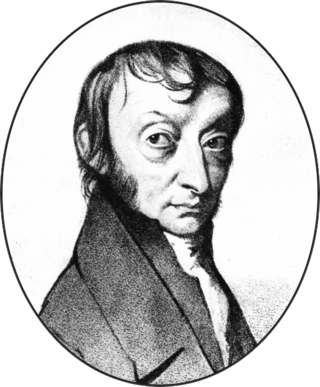Related Research Articles

The Avogadro constant, commonly denoted NA or L, is an SI defining constant with an exact value of 6.02214076×1023 mol−1 (reciprocal moles). It is defined as the number of constituent particles (usually molecules, atoms, ions, or ion pairs) per mole (SI unit) and used as a normalization factor in the amount of substance in a sample. In the SI dimensional analysis of measurement units, the dimension of the Avogadro constant is the reciprocal of amount of substance, denoted N−1. The Avogadro number, sometimes denoted N0, is the numeric value of the Avogadro constant (i.e., without a unit), namely the dimensionless number 6.02214076×1023; the value chosen based on the number of atoms in 12 grams of carbon-12 in alignment with the historical definition of a mole. The constant is named after the Italian physicist and chemist Amedeo Avogadro (1776–1856).

Lorenzo Romano Amedeo Carlo Avogadro, Count of Quaregna and Cerreto (, also, Italian:[ameˈdɛːoavoˈɡaːdro]; 9 August 1776 – 9 July 1856) was an Italian scientist, most noted for his contribution to molecular theory now known as Avogadro's law, which states that equal volumes of gases under the same conditions of temperature and pressure will contain equal numbers of molecules. In tribute to him, the ratio of the number of elementary entities (atoms, molecules, ions or other particles) in a substance to its amount of substance (the latter having the unit mole), 6.02214076×1023 mol−1, is known as the Avogadro constant. This constant is denoted NA, and is one of the seven defining constants of the SI.
Avogadro's law or Avogadro-Ampère's hypothesis is an experimental gas law relating the volume of a gas to the amount of substance of gas present. The law is a specific case of the ideal gas law. A modern statement is:
Avogadro's law states that "equal volumes of all gases, at the same temperature and pressure, have the same number of molecules."
For a given mass of an ideal gas, the volume and amount (moles) of the gas are directly proportional if the temperature and pressure are constant.
The year 1787 in science and technology involved some significant events.
The year 1832 in science and technology involved some significant events, listed below.
The year 1838 in science and technology involved some significant events, listed below.
The year 1818 in science and technology involved some significant events, listed below.
The year 1776 in science and technology involved some significant events.
The year 1804 in science and technology involved some significant events, listed below.
The year 1777 in science and technology involved some significant events.
The year 1875 in science and technology involved some significant events, listed below.
The year 1797 in science and technology involved some significant events.
The year 1800 in science and technology included many significant events.
The year 1865 in science and technology involved some significant events, listed below.
The year 1774 in science and technology involved some significant events.
Gay-Lussac's law usually refers to Joseph-Louis Gay-Lussac's law of combining volumes of gases, discovered in 1808 and published in 1809. However, it sometimes refers to the proportionality of the volume of a gas to its absolute temperature at constant pressure. The latter law was published by Gay-Lussac in 1802, but in the article in which he described his work, he cited earlier unpublished work from the 1780s by Jacques Charles. Consequently, the volume-temperature proportionality is usually known as Charles's Law.

Bernard Courtois, also spelled Barnard Courtois, was a French chemist credited with first isolating iodine, making early photography possible.

The history of chemistry represents a time span from ancient history to the present. By 1000 BC, civilizations used technologies that would eventually form the basis of the various branches of chemistry. Examples include the discovery of fire, extracting metals from ores, making pottery and glazes, fermenting beer and wine, extracting chemicals from plants for medicine and perfume, rendering fat into soap, making glass, and making alloys like bronze.

In chemistry, the history of molecular theory traces the origins of the concept or idea of the existence of strong chemical bonds between two or more atoms.
References
- ↑ Swain, Patricia A. (2005). "Bernard Courtois (1777–1838), famed for discovering iodine (1811), and his life in Paris from 1798" (PDF). Bulletin for the History of Chemistry. 30: 103–11. Archived from the original (PDF) on July 14, 2010. Retrieved 2011-05-24.
- ↑ "Michael Faraday". Famous Physicists and Astronomers. Retrieved 2007-03-12.
- ↑ Crilly, Tony (2007). 50 Mathematical Ideas you really need to know. London: Quercus. p. 33. ISBN 978-1-84724-008-8.
- ↑ Bell, C; Shaw, A (1868). "Reprint of the "Idea of a New Anatomy of the Brain," with Letters, &c". J Anat Physiol. 3 (Pt 1): 147–82. PMC 1318665 . PMID 17230788.
- ↑ "Francis Place". Spartacus Educational. Archived from the original on 2007-08-06. Retrieved 2011-10-12.
- ↑ Patented in 1810. Meggs, Philip B. (1998). A History of Graphic Design. Wiley. pp. 130–133. ISBN 0-471-29198-6.
- ↑ "Copley Medal | British scientific award". Encyclopedia Britannica. Retrieved 21 July 2020.